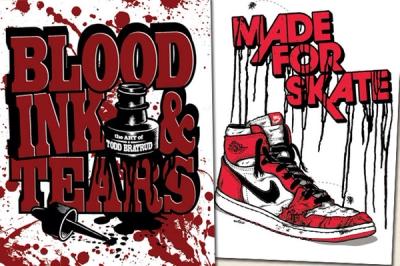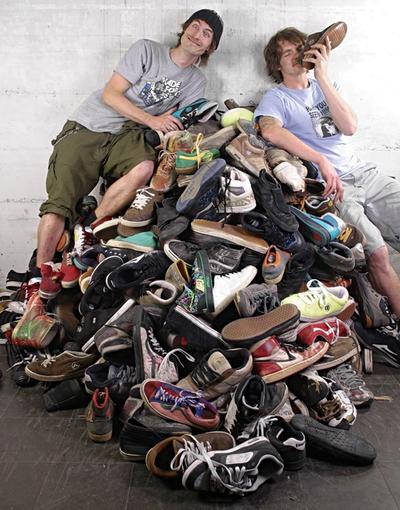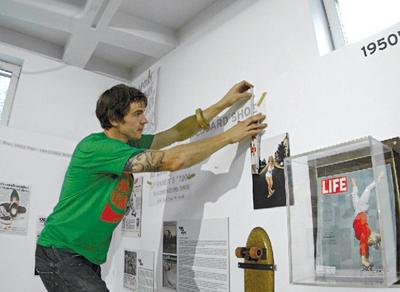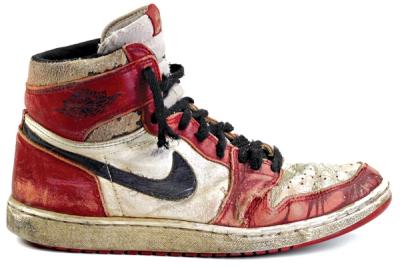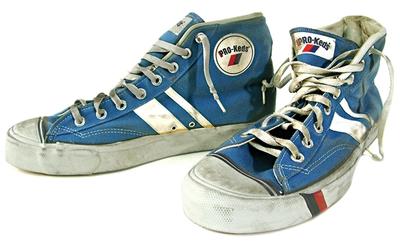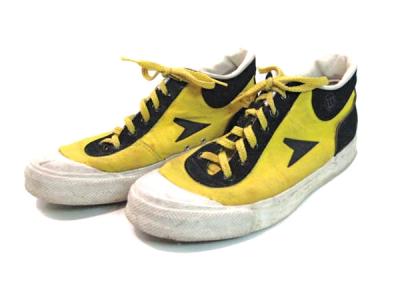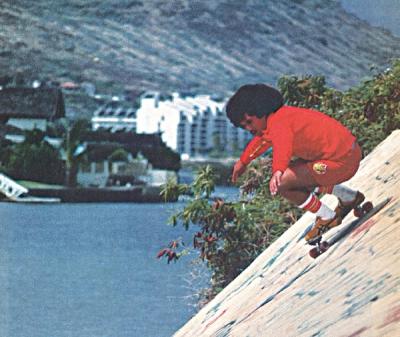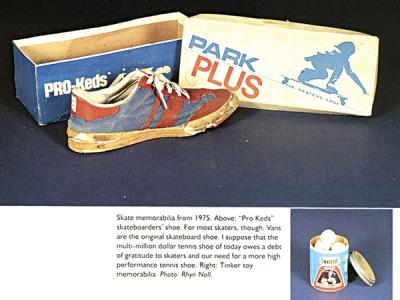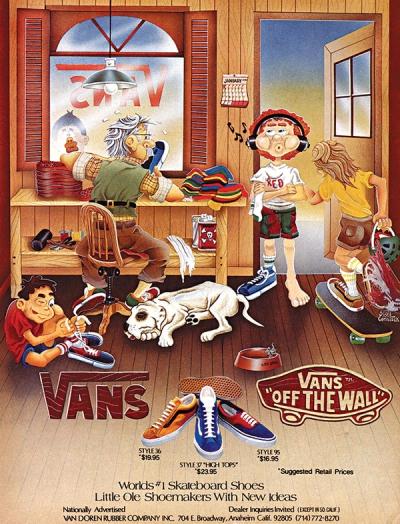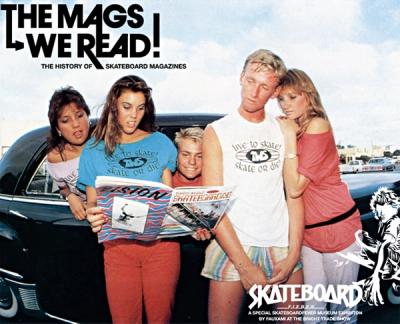Made For Skate - Vintage Skate
Further to our quest to bring you everything we can on the earliest years of skateboarding shoes, we were very pleased to clock Juergen and Daniel, two Stuttgart natives who are so obsessed with the history of skating, they started their own museum. Now a travelling roadshow with a string of European dates already behind them, the boys continue to amass what is without doubt, the biggest collection of beater skate shoes in the world. What many throw in the trash, these guys scoop up and hang on a gallery wall. As they say, there is no soul in a new shoe... and who are we to argue?
Hey guys, fill us in on your personal history?
JUERGEN In 1987 I bought a seventies shaped plastic skateboard from a good friend for 10 marks (former German currency). In 1988 at my fifteenth birthday, I got the money together to buy my first real board. In 1989 I started working in a skate shop next to school and later I became sponsored... well my school grades went really down and my parents were absolutely anti-skateboarding but my ollies were popping higher! In 1994 I finally finished school and as a gift from my parents, I made a trip with friends to skate sunny California. I still love to (rock’n) roll!
DANIEL Around 1988 I was watching some older guys at school skating and I was immediately fascinated. A classmate had a crappy supermarket skateboard called Street Rat, with which I learned how to ‘tic-tac’ and tried the first boneless ones in front of our house. No way for the ollie though, since the board weighed a ton and I was really small in those days. Then I saved all my money from doing paper routes and mowing lawns and in 1989 I was finally able to buy my first real board. It was a Santa Cruz ‘Corey O’Brian’ with Tracker trucks and the cheapest set of wheels from SchmittStix, because that was all I could afford. There was no more excuses for not learning how to ollie and shortly after came the love for skulls and the Dead Kennedys, which is still there today.
Who were your idols when you were kids?
JUERGEN The Bones Brigade was huge for me! Vallely and Mullen were my personal heroes and I was even imitating Mullen’s fingers position, but I was looking up to most of the eighties and nineties pros and my local German hero was of course Claus Grabke.
DANIEL Ray Barbee and Mike Vallely (first video I saw was Public Domain from Powell), Matt Hensley from former H-Street and a little later Ed Templeton from New Deal. On the halfpipe it was Tony Hawk, Danny Way and Lance Mountain. Then after seeing a Powell Demo with Tony Hawk doing ten McTwists in a row on a shitty narrow halfpipe I thought, ‘yeah he’s a great skater, but his style is really a little weird’.
Skating evolved more or less from youth fads – scooters and roller skate wheels adapted to planks of wood. Do you think most kids are actually aware of how far back the sport goes?
When we started skateboarding we didn’t know anything about the history! So the kids of today don’t know much of the historical stuff. Maybe they have seen the Dogtown documentary or the Lords of Dogtown film? We only took notice of what was happening around us in the present moment and because there was so much going on and new to discover, it was enough. But it is nice to show the kids how it all started and where the different influences came from. Especially with the crazy stuff people were skating back then, the boards, wheels and tricks and how close it has been for skateboarding several times to die forever. There are not many sports that started barefooted and today we have high-tech supershoes next to ramps that look like huge ski jumps.
Can you explain the significance of the wheels evolving from metal to clay to urethane?
The change from metal to clay to urethane is a whole story for itself. But to keep it short, the main significance is that the urethane provides the skater with grip, shock absorption and cushioning and not to forget, a lot of speed. Urethane opened the door for today’s skateboarding, suddenly you could do all the moves and skate every terrain in a limitless manner.
And how did you develop the skateboard museum?
It started with a two week exhibition in late 2003, after finding an empty basement in Stuttgart. Until opening night we kept gathering every skateboard related item we could get from our friends, shops, former pros and team managers who still lived in Stuttgart (eg. Mathew Bauer / Santa Cruz, Fritz Klein / Zorlac and Joerg Ludewig / Urban Supplies). When the two weeks were over we thought it would be a shame to just tear everything down and leave behind an empty space, so we decided to just stay and see what happens. After almost a year of squatting, we had talks to some city officials and asked for permission to stay and make it permanent. From January 2005, the Museum is open once a week on Sundays or for special events. All for free!
Now that’s showing some initiative. Your museum is also touring, with dates in London and various European cities... what else have you got planned?
Yeah the touring part is great fun. We thought that it was not so easy for skaters to travel to Stuttgart, so our first stop was Berlin where we had a huge venue with two floors and we could integrate a big mini-ramp. The next stop was Barcelona in a very famous gallery called Iguapop. At this time we focused on the art side of skateboarding and invited Andy Howell, Jeremy Fish, Stefan Marx and the Spanish artist Davilock. We have now a gallery space integrated in the Museum where we had a Jeremy Fish exhibition and a Claus Grabke retrospective. Right now we show the ‘Dirt Ollies’ exhibition and are planning a Stefan Marx exhibition later this year. We are also doing skate-culture expos at the Bright Skateboarding trade show in Frankfurt. Skateboarding is totally versatile so we always try to show a special topic.
This year we showed the World Industries retrospective ‘Censorship is weak as Fuck’ and the year before we had ‘The Mags we Read’ which was a history of skateboard magazines and ‘’, the history of skateboard shoes. The Made for Skate expo had such an impact that we were able to show it after Frankfurt in London and Vienna – we think that we can say we have the largest collection of skate shoes so far. And right now we are working on the Made for Skate Book – an illustrated history of skateboard shoes.
A book sounds well overdue – is it just shoes?
It’s all about skate shoes! We will not show a single skateboard in the book (just in the ads of course), just hard skated and thrashed shoes next to very special ones. We would say there is no other sport out there which focuses more on footwear. Skateboarders have always paid a lot of attention to shoes. After all, they’re what connects us to our boards – and to the world at large. Skaters know what difference a pair of shoes can make. We test them to the limits, wear them down, skid them across griptape and hot pavement. We will cover the whole history and the present in terms of brands, famous and popular shoes, signature models, trends and styles. You will see many shoes that are long forgotten which will bring back the emotions you had when you pulled a new trick or skated a special spot.
The evolution of boards is well documented, but I haven’t been able to find much on the sneakers?
Those things always depend on the interest of the people.
In our museum, shoes have always been part of the exhibition, since they are witnesses of long gone, hard skating times. For collectors though, the ‘new’ shoes seem to be more interesting. But for us, the shoe only had a life (and therefore a history) when it was truly ripped down to the sole. There was not much demand for ripped skate shoes as a collector and I guess still isn’t. Skateboard decks for example with their graphics, are items which are much more attractive for people to collect. I mean, who wants to collect stinky, dirty, ripped and thrashed shoes? We do! There is no soul in a new shoe!
I guess a lot of the shoes were just thrashed and disposed of? How did you collect all the old shoes?
We announced a campaign called ‘Made for Trade’ in magazines, skate forums and blogs, where people could exchange their old thrashed shoes for new ones. The rest came from companies, friends and everyone we ran into we asked for their stinking relics. The boards are from friends, former pros, Urban Supplies distribution and the SKATELAB skateboard museum from Todd Huber in Simi Valley CA is a big supporter.
I’m interested in how deep you go back in time. Which model do you regard as the definitive and first skate shoe?
It started with boat shoes and then in 1965 the ‘Randy’s 720’ entered the skateboard scene!
I know Randy’s. We have some very early advertising here for their ‘720’ shoes... do you know much about the company?
On the first Randy’s ad you see Mark Richards from Val Surf spinning a 360. Val Surf was the first skate shop in the US. They opened their doors in 1962 and in 1965 you could buy the Randy’s skateboard shoes there. They were an advanced design of the common boat shoes – they had a thicker toe and heel sole backing for nose and tail spins. On the cover of the third issue of Skateboarder Magazine you can see a guy in the background wearing Randy’s – and you can see the red and blue part of the sole. The red was the ‘Randyprene’ also known as the ‘rubber with TUFFNESS!’
Aside from Randy’s, everyone else in this era looked like surfers in bare feet. The early LIFE magazine article is interesting, it was quite anti-skating...
In history people normally like simple explanations. So today you still can read that surfers have invented skateboarding. Well it’s more the point that surfers made it very popular in the late fifties to the mid sixties. The bloodline that leads to skateboarding is very mixed – from ice skates to rollerskates, the Flexi-flyer and Orangecrate scooters to the first garage-made skateboards. But the influence of surfers was a huge impact! They were imitating the moves and styles from surfing and so the first articles about sidewalk surfing appeared in the early sixties in surf magazines. The famous Life cover with Patti McGee doing a barefooted handstand was a hoax to skateboarding culture. In May 1965, they portrayed skateboarding as ‘Mania and Menace!’ Next to accident statistics and gruesome tales of rebellious misconduct, the article featured a picture of a mangled foot. ‘It’s easier to get bloody than fancy’ the article concluded, and upright citizens should leave it alone. The article was one nail in the coffin for the death of the first skateboard wave.
Well some things never change. The story from the second era is really all about Vans – what made the brand so cool?
They had no other competitors in the early days, and they definitely had good grip for skating. Originally intended as sailing or beach shoes, Vans became aware of their skate following, so they produced style #95 (designed by Tony Alva) followed by style #34, then hightops called style #38. They sponsored a lot of skateboarders and contests, and they were the first shoe company to advertise in early Skateboarder magazines. So everybody knew them. Vans also was the first company which paid a professional skateboarder to wear their shoes and so Stacey Peralta became the first to receive endorsement cheques from a shoe company.
There are other less known brands from this era that never survived such as Hobies and Makaha?
Hobie and Makaha were the first skateboard manufacturers that started to produce shoes. Makahas had a pretty innovative sole which looked like suction cups of a squid. Also their bright colors and the synthetic material was pretty outstanding for skateboard shoes of that time. The Hobies even had a toe cap reinforcement.
Are there others that you know of?
Skateboarders used all kinds of sneakers to skate in. So there were a lot of no-name shoes on the feet of skateboarders. Hang Ten had a shoe just for skateboarding, but the shoe looked more like a golf shoe. The brand Wilson and Dunlop, famous for tennis shoes, had special skateboard shoes too. Keds had a model called Park Plus and there were even special skateboard shoes for kids called ‘Kid Power’!
How do you see Nike fitting into the skate shoe picture? They had tremendous success in the seventies and eighties but found it much, much harder when they tried to come back.
Lucky for us, Nike came back into skateboarding when we started with the exhibition, because they were the first ones to support our idea. With all their back stories, it is only normal that the scene had a very suspicious eye on their actions, but since they had quality products and a credible team, they found good support with their SB line.
Nike learned a lot from their first effort in 1997. They had a nice campaign called ‘What if’ which you still can see on and in our book. Nike showed in a very funny way, the shit that happens to skateboarders, like being kicked out of a spot by security guards to being laughed at by people who think skateboards are a toy for kids. But it felt weird to the skate society that Nike did try to speak for them. Especially in the late-nineties, skaters were a lot more against big brands. So the second time round, Nike got the right people and they ran it very good. And like in our case, this time they are really giving back something to the community. Oh yeah and by the way, the first Nike skate shoe was shit according to Big Brother magazine. Well that changed too.
They seemed to be a lot more successful when they weren’t actually trying to design skate shoes. Look at the first Jordan and before that the Blazer. Does that seem ironic looking back at it now?
Especially in Europe in the early eighties, it was much easier to get a pair of Nike basketball shoes than Vans. There were less skate shops, but you could just go into a sport retailer and buy a Blazer or later on, the Dunks. If you look back into the magazines of the late seventies you just see Nike and Vans hightops. Even in the US, Nike basketball shoes were huge. They had very good material, cushioning and stability, all the demands for a pool or halfpipe shoe. The first team Nike supported was the Bones Brigade in the mid-eighties. So they got a very good shoe care package from them. And I think most of you know the famous hand-plant photo on the chin ramp taken by Grant Brittain where most of the Bones Brigade are wearing the Air Jordan 1. In a way this shoe was a blueprint for all the modern hightop skateboard shoes in the late eighties (like the Airwalk Prototype). And the Dunk is still a simple and very good skateboard shoe. Oh and the funny thing is, 21 years later there are Jordan skateboard shoes!
Do other brands have a credible skate history?
Sure, Converse Chuck Taylor All Stars were very popular in the fifties to sixties and they had a big renaissance in the late eighties with pro-skaters like Hosoi, Mullen and Vallely. We have a picture from 1974 showing Larry Bertleman skating with Asics shoes. In European skateboard magazines, most of the skaters in the seventies skated in adidas and Puma. And in the late eighties you can see the Puma First Round on the feet of Hawk, Hosoi and Eric Dressen.
Adidas and even Puma have recently decided to muscle back into the skate footwear market. How does that sit with you guys?
Actually they were in skateboarding before Nike. Apart from skaters who used the Gazelles or the Clydes around 1992–94, adidas came out with a skate shoe line in 1996 (after their ‘Super Skate’ model from 1973!) Today they gather steam with a strong team including Mark Gonzales, Dennis Busenitz and Tim O’Connor. Puma tried around 1997–98 with a pro model for Kien Lieu and nowadays Scott Bourne is their figurehead. So why shouldn’t they also be there, next to all the others who want to have their piece of the cake? As long as they bring something back to skateboarding, everybody can decide for themselves which shoes to buy.
What do you regard as the biggest innovation in skate shoes?
Shoe Goo!
Ok... Do you think we are at the threshold for technology on skate shoes?
Every time you look back in history and think that everything has already been invented and is not gonna change anymore, you were proven wrong. So with all the recycling materials used and the hidden high-tech features in the shoes, there is going to be more to come for sure. Who knows for how long it is going to be normal to wear two similar shoes?
Thanks for your time. Anything else you want to say to our readers?
Come to Germany, visit the museum in Stuttgart and keep an eye out for our book. Thanks to you and the Sneaker Freaker readers. Enjoy life, ride a skateboard!
